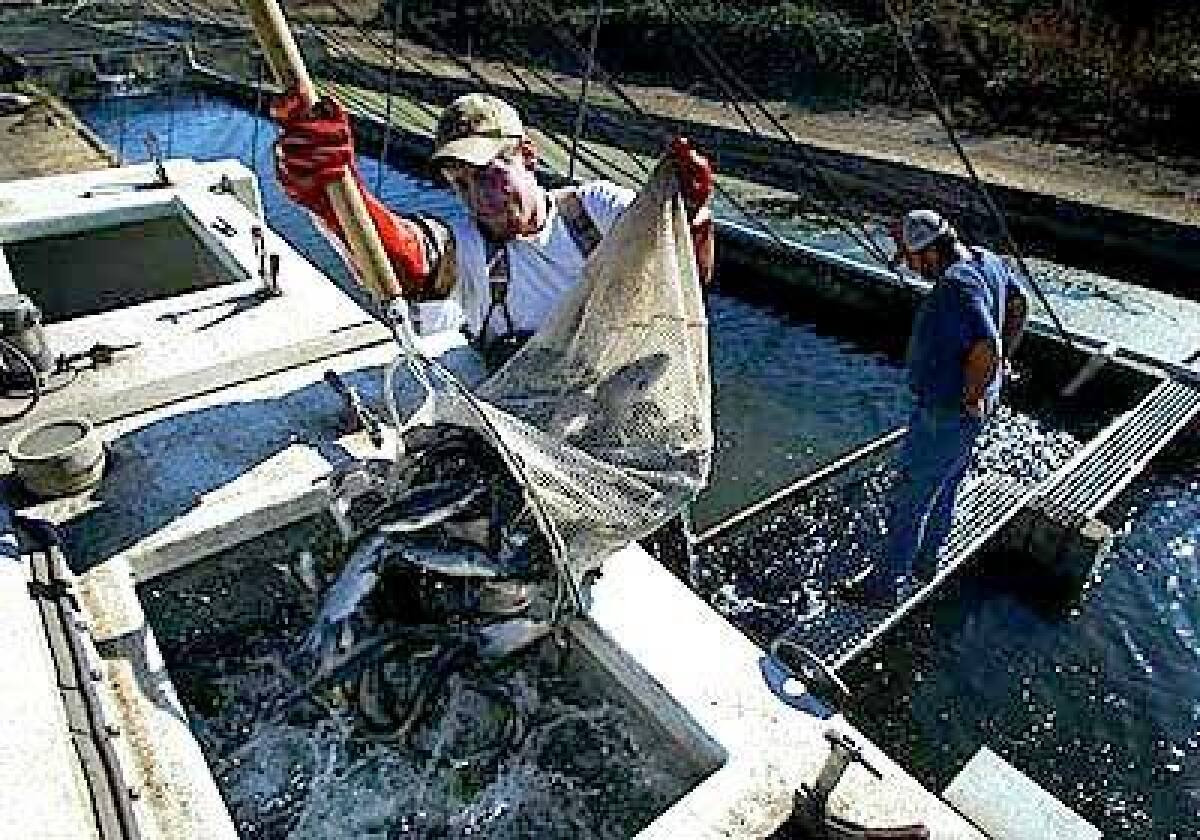Where mainstreaming hurts

- Share via
Last year, California wildlife officials heaved 14 million hatchery-raised trout from trucks or airplanes into streams, lakes and reservoirs. The purpose of this $12-million exercise? To make it easier for people to catch lots of fish — even at the expense of native species.
“You’re putting true domestic animals into the wild and they satisfy a demand for people, especially kids, to catch fish,” says UC Davis fisheries biologist Peter Moyle. “But the downside is you can overwhelm the genetic stock of the wild fish and your streams can become addicted to hatchery fish.”
Whirling disease, a fatal condition caused by a parasite, was introduced in Colorado from a private hatchery in the 1980s. Now found in 20 states, including California, it has contributed to the decline of wild rainbow trout in the Rocky Mountains.
Moyle says planted trout displaced wild trout on the north fork of the Feather River near Quincy, Calif. A similar trend emerged in the Kern River drainage with golden trout before the state acted to stop it.
The state Department of Fish and Game also halted trout plants in Sespe Creek to protect steelhead, and it is trying to eradicate planted trout in Sierra lakes high above Big Pine to protect the mountain yellow-legged frog, a rare species.
Purists make an aesthetic argument against hatcheries. They ask: Are we such a state of ninnies that we can’t hook a trout without the help of Big Brother?
“If we were to take the hatchery fish away for a period of time, we’d have some people with the skill level who could catch fish, but over time those numbers would drop,” says Michael Haney, a supervising biologist for the Fish and Game Department.
The conundrum is that California owes its productive trout fishing largely to hatcheries. Domesticated fish also sustain urban fisheries. Stocked lakes and ponds in cities provide angling opportunities for people who can’t afford a trip to the Sierra or Northern California. Haney says catching hatchery trout gets people involved in sport fishing and acquaints them with the environment.
But the state budget crisis threatens hatcheries. About $2.6 million has been lopped from the department’s hatchery coffer since 2001, and it has lost 20% of its workers.
Some rural towns in the Eastern Sierra fear tourists will come only if local streams and lakes cough up plenty of lunkers. Gary Gunsolley, owner of Brock’s Flyfishing Specialist in Bishop, says fishing pumps billions of dollars into the state’s economy. Lose hatcheries, he says, and anglers will wipe out wild trout.
“It would not only be devastating to the Eastern Sierra, it would be devastating statewide. Just having wild trout is not the answer,” Gunsolley says.
But others say some money spent on hatcheries might be better used to restore native trout habitat.
“Is it better to spend money on the status quo, or is it better to spend some of it and open 10 miles of habitat for steelhead or native trout in the Sierra that was previously inaccessible?” asks Chuck Bonham, an avid fly-fisherman and attorney with Trout Unlimited, a conservation group. He says he would rather get skunked than land a fish raised eating pellets dropped into a giant trough.
Sometimes, nature works a compromise when domestic trout become self-sustaining populations of pseudo-wild trout. For example, streams in Tuolumne Meadows in Yosemite National Park that were fishless until the late 1800s when stockers arrived now teem with quality browns, eastern brookies and rainbows.
“If a stream can support wild trout, we should leave it alone because there is no reason to put planted fish there,” says William Look, a Monterey attorney who wrote “High Sierra Fly Fishing” under the pen name Billy Van Loek. “Fishing is a skill sport, and just as children learn to play baseball or soccer, they can certainly learn to fish.”
More to Read
Sign up for The Wild
We’ll help you find the best places to hike, bike and run, as well as the perfect silent spots for meditation and yoga.
You may occasionally receive promotional content from the Los Angeles Times.






